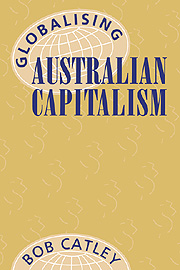Book contents
- Frontmatter
- Contents
- List of Tables
- List of Figures
- Preface and Acknowledgements
- List of Abbreviations
- Introduction
- 1 The International System and the End of the Cold War
- 2 The World Market and the Industrial Revolution in Asia
- 3 The Australian State and Economic Development
- 4 Economic Rationalism Changes Australian Politics
- 5 Government and Business in Australia
- 6 The Public Sector Reinvented
- 7 Australian Industry Restructures
- 8 Geographic Dimensions of Change
- 9 Australia Joins the Asia-Pacific Region: from ANZUS to APEC
- 10 All in a Day's Work
- Notes
- Index
3 - The Australian State and Economic Development
Published online by Cambridge University Press: 14 January 2010
- Frontmatter
- Contents
- List of Tables
- List of Figures
- Preface and Acknowledgements
- List of Abbreviations
- Introduction
- 1 The International System and the End of the Cold War
- 2 The World Market and the Industrial Revolution in Asia
- 3 The Australian State and Economic Development
- 4 Economic Rationalism Changes Australian Politics
- 5 Government and Business in Australia
- 6 The Public Sector Reinvented
- 7 Australian Industry Restructures
- 8 Geographic Dimensions of Change
- 9 Australia Joins the Asia-Pacific Region: from ANZUS to APEC
- 10 All in a Day's Work
- Notes
- Index
Summary
Modern Australia was created by the British Empire and it developed its basic national characteristics during the period of British hegemony in the international system. Like the other societies of the Asia-Pacific region which entered the world market during the epoch of European dominance, Australia has had to adapt to the post-colonial era and the emergence of an Asia-Pacific economic community which has displaced those centred on European imperial systems. Each of these societies entered the world economy and made use of its developmental opportunities and responded to its technological challenges in different ways. Japan was able to use its developed feudal social structure and strong state apparatus to create a developed core economy in record time. More commonly these societies were annexed to imperial systems and became the satellite providers of raw materials and cheap labour. Australia became a semi-peripheral settler-democracy, wealthy in a poor colonial region.
Settlement
The British government established a penal colony in Sydney in 1788 as a self-supporting convict settlement and source of naval supplies. During the next sixty years about 160000 convicts arrived who effectively provided slave labour for the integrated colonial and private economies. Free immigrants followed to seize land from the indigenous hunter-gatherer population whose right to occupancy was, with few exceptions, ignored. At first the settlement was run much as a military dictatorship. But as more convicts were freed and more smallholding and labouring free immigrants settled, demands for self-rule emerged.
- Type
- Chapter
- Information
- Globalising Australian Capitalism , pp. 43 - 64Publisher: Cambridge University PressPrint publication year: 1996



